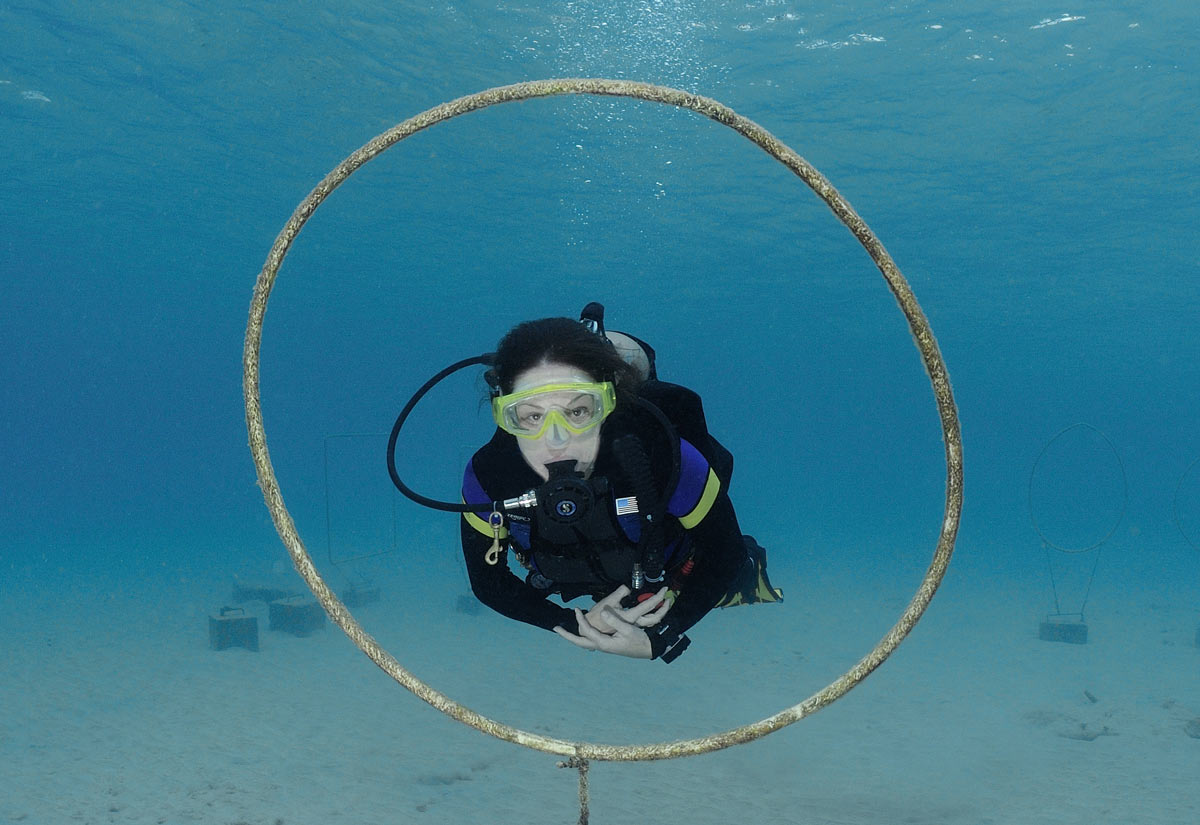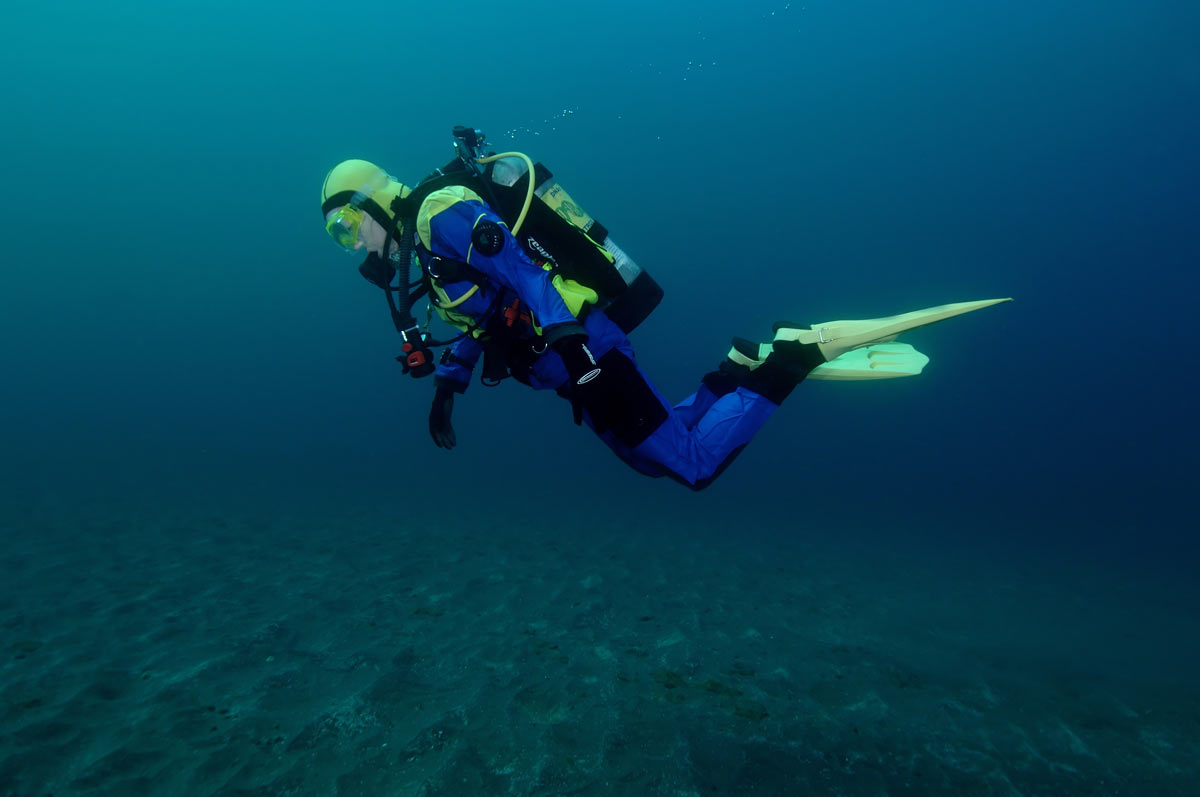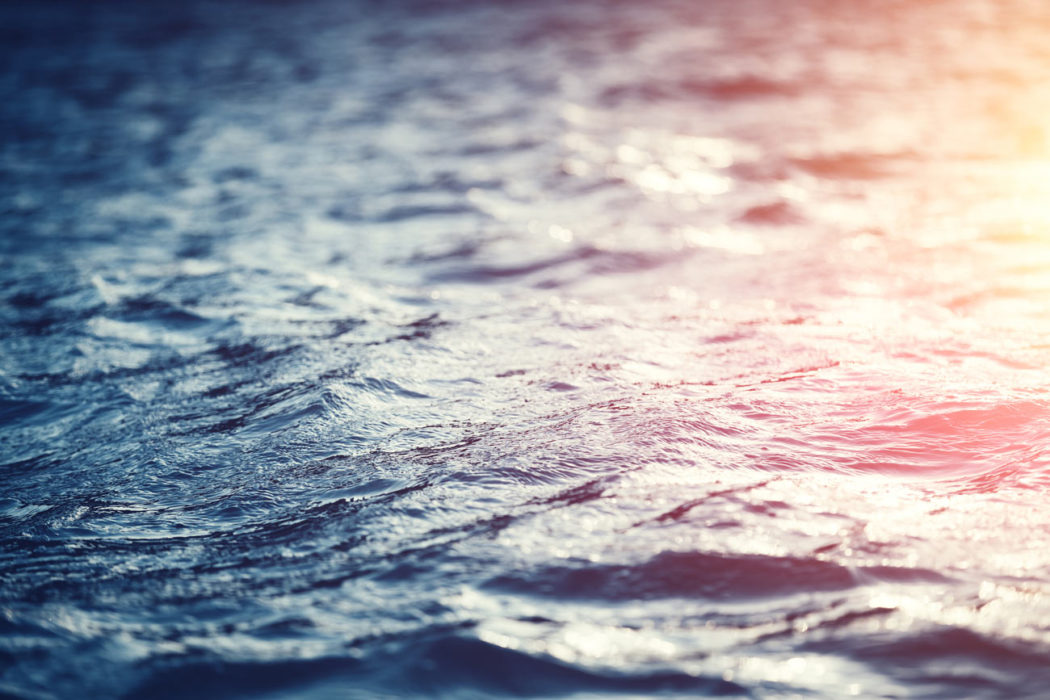Jonah Kayton slips silently beneath the waves, and begins a slow descent with his buddy to the wreck waiting below. Sensing the acceleration in his descent, he squeezes the inflator button in his left hand, releasing a short burst of air into his buoyancy compensator (BC) that slows his descent. His right hand pinches the nose pocket in his mask, and he blows gently to relieve the pressure building in his ears. Kayton quickly checks his depth gauge, cylinder pressure and dive computer, and flashes his buddy the “OK” sign as the descent continues. Every few feet, Kayton repeats the adjustments — adding air to his BC in short bursts, clearing his ears, and checking his gauges and buddy. The image of a sunken boat materializes out of the deep blue haze beneath, and Kayton gently settles onto its deck. A blast of bubbles from his exhaled laughter signals his arrival. He looks up and watches the silvery bubbles as they expand on their quickening journey to the surface. In more than one sense, he has arrived.
To Kayton, this dive is the culmination of all his training and experience, beginning with an introductory dive off the shores of Hawaii, his open water certification, advanced open water, and now a wreck diving specialty course. And while he recognizes the efforts of his instructors in bringing him to this point in his diving career, he probably hasn’t thought about the contributions made by countless scientists, engineers, mathematicians and explorers that came before him. Sure, every diver owes a debt of gratitude to Emile Gagnan and Jacques Cousteau for inventing the demand regulator, but few divers, including Kayton, would pause for the briefest moment to consider the contributions made hundreds and even thousands of years ago to the modern science of scuba diving. Even in his relatively short descent to the deck of this nameless wreck, the efforts of the finest minds of their time — Dalton, Boyle and even Archimedes — play a distinctive and honored role.
Archimedes and The Mystery of the Crown
Rewind about 2,200 years to the Greek city of Syracuse. King Hiero was suspicious. He had given a lump of gold to a goldsmith from which a crown would be crafted. But when the project was finished, Hiero sensed he had been cheated. Although the crown weighed the same as the gold he had given the goldsmith, he had nagging doubts about the integrity of the goldsmith. He sensed the goldsmith had stolen some of the gold and replaced it with silver. Not wanting to destroy the crown to learn the truth, Hiero turned to the most respected engineer of the time — a man named Archimedes.
Archimedes was both flattered by the trust placed in him by Hiero, and concerned. He could certainly make the determination of the crown’s material, but not without causing serious damage in the process. He pondered this plight for some time, realizing that his reputation hung in the proverbial balance. The answer to his plight came suddenly one day at the public bath. While stepping into the water, Archimedes noticed that the level of the water rose. The story goes that Archimedes ran through the streets of Syracuse shouting, “Eureka!” which translates to “I found it!”
What he had found was a remarkably simple way to test the goldsmith’s honesty. Archimedes took a block of gold weighing the same as the crown, and submerged it in a full vessel of water, taking careful note of the quantity of water that spilled in the process. Next, he submerged the crown in the same vessel filled with water, and noted that more water was spilled. Archimedes knew that silver was less dense than gold, and so a crown made of a lighter material (gold mixed with silver) would displace more water than one made of pure gold. Hiero’s suspicions were confirmed. The goldsmith was found guilty, and Archimedes’ reputation endured.
Archimedes is credited with numerous inventions, including various war machines, the water screw, the planetarium, and technologies used in the defense of Syracuse against the Romans. But it’s his principle of buoyancy for which divers should be most grateful. Archimedes determined that an object submerged in water displaces a volume of water equal to that of the object. More importantly, he found that the buoyant force or “lifting force” on that submerged object is equal to the weight of the displaced water.

By remaining neutrally buoyant, divers can safely enjoy the reef without becoming overexerted — and without damaging the reef.
Buoyancy Basics — Archimedes’ Principle in Action
For divers, there is no escape from the principles that Archimedes so cleverly employed. For most purposes in diving, we wish to have neutral buoyancy so that we neither sink nor float. In this condition, we can use all our propulsive force to move us through the water. Using some of our propulsive force to keep us at our desired depth means we expend more energy and consume more of our most precious resource — air. Our primary means of adjusting buoyancy is our buoyancy compensator, or BC. By adding air to our BC, we increase our volume without adding or losing weight. Thus we displace more water, and the buoyant force acting upon us is increased. By venting air from our BC, we decrease our volume, thus decreasing the buoyant force acting upon us, and we begin to sink.
Buoyancy Under Pressure
On the face of things, it would seem a simple matter to adjust our buoyancy at the beginning of a dive so that further changes would be unnecessary. In the early days of scuba diving, divers didn’t use BCs, but instead relied on a more “brute force” approach to maintaining depth. The primary problem is that throughout a dive, our volume is constantly changing. As we descend, the pressure around us increases, and both divers and their gear become compressed. The tiny voids in our exposure suits begin to collapse, our BC is squeezed to a smaller volume, and our mask pushes closer against our face. Even the air spaces within our bodies — our lungs, sinuses and intestines — are all affected by changes in pressure, and accordingly change in volume.
Here again, we find the efforts of great minds of the past interwoven with our sojourns into the depths. Robert Boyle, who was born some 1,800 years after Archimedes, was another great mind of his time. An Irish physicist and “natural philosopher,” he is considered a founder of modern chemistry, a pioneer of the scientific principle, and is responsible among his other credits for the invention of the match. Although he was the first to record a description of “decompression sickness,” he is best-known to divers for “Boyle’s law,” which defines the inverse relationship between the pressure and volume of a fixed mass of gas at a constant temperature.
According to Boyle’s law, the pressure of a gas times its volume is constant, as long as the temperature remains the same. So if we double the pressure, the volume is reduced by half. If we triple the pressure, the volume is one-third. Obviously, this comes into play when dealing with our buoyancy. Descending from the surface to a depth of 33 feet (10 m) in seawater, we double the pressure. Unless we add air to our BC, its volume will reduce by half as we descend to 33 feet. Since our volume is less, we displace less water, and our buoyancy decreases as well.
Boyle’s law can be bad news in an unchecked descent, as our rate of descent will accelerate. As the pressure increases, our volume decreases and our buoyancy becomes less, causing us to sink faster with each foot we descend. To adjust for the effect, we must add air to our BC to maintain a constant volume, and thus a constant buoyant force to support us.
The principle also applies for an ascent. As we ascend from 33 feet to the surface, the volume of air in our BC will double, displacing more water, and adding to our buoyancy. Just as with our descent, an unchecked ascent can lead to an uncontrolled situation, with a diver rocketing out of control to the surface. Just as we must add air to our BC on the descent to maintain neutral buoyancy, we must vent air from our BC on the ascent to maintain neutral buoyancy.
TIPS FOR BUOYANCY CONTROL
- Check your buoyancy at the beginning of each dive to make certain you’re carrying the proper amount of weight.
- Adjust your trim to maintain the desired underwater attitude.
- Use short bursts to inflate and deflate your BC.
- Control your breathing to make minor buoyancy adjustments.
- Adjust your weights to adjust for fresh or salt water.
- Log your equipment and buoyancy data for each dive. Then use this data to plan future dives.

Buoyancy control is an important skill that each diver should master. And it takes practice. Here, a diver fine-tunes her buoyancy skills by swimming through an underwater “obstacle course.”
Salt to Freshwater Transitions
Archimedes was also a brilliant mathematician. Among his mathematical accomplishments, he figured out how to calculate the area between a parabola (a type of curved line) and a straight line. While this might sound mundane, it might have been important to the shipbuilding industry, since it would allow a naval architect or shipbuilder to calculate the volume of a ship’s hull. Armed with this information, one could also calculate the ship’s buoyancy, and the draft of the ship while carrying different amounts of weight.
Such information would be particularly useful as a ship transitions between salt and fresh water, for example, traveling from the open ocean up a river. Since fresh water is less dense than seawater (the salt in salt water adds weight), the buoyancy of the ship in fresh water is less, and it rides lower in the water.
While we might not worry too much about such transitions in a dive boat, divers must make some adjustments to their dive gear when transitioning from salt to fresh water if they hope to maintain neutral buoyancy. Since we’re less buoyant in fresh water, we need less weight on our weight belt to achieve neutral buoyancy. The question is, how much?
Let’s take an example of a diver who weighs 185 pounds (83 kg), carries a 38-pound (17 kg) scuba unit, a 6-pound (2.7 kg) exposure suit, a 17-pound (7.7 kg) weight belt, and another 10 pounds (4.5 kg) of accessories for a total weight of 256 pounds (115 kg). If the diver is neutrally buoyant, he displaces 256 pounds of seawater — an amount equal to his total weight. At 64 pounds per cubic foot of seawater, the diver with all his gear must have a volume of exactly 4 cubic feet.
Now let’s take that same diver, and put him in fresh water. He still displaces 4 cubic feet of water, but now the water is less dense, weighing 62.4 pounds per cubic foot. Our 4-cubic-foot diver now displaces only 250 pounds (113 kg) of water, or 6 pounds less than he did in seawater. So to compensate, he should take about 6 pounds from his weight belt to maintain neutral buoyancy (a little less actually, since the lead weights have some buoyancy).
If that diver were to wear the same gear in fresh water as he does in salt water, he would need to compensate by adding more air in his BC. While this might work, he would have a greater challenge, and use more air, attempting to maintain neutral buoyancy throughout his dive. Since his BC would start out with more air, it would experience a greater volume change as he descended, requiring him to add more air to compensate. On the ascent, his BC would expand more, and he would need to vent more air to maintain neutral buoyancy.
The transition from fresh water to salt water is more problematic. If we enter the ocean equipped the same as we are for a neutrally buoyant freshwater dive, we won’t have enough weight to counteract the buoyant force acting upon us. The only reasonable answer is to add more weight.

It’s one thing to be neutrally buoyant in the water, but divers must also have the proper attitude or “trim.” To move horizontally through the water, it is critical that the diver’s weight and buoyant forces be distributed properly.
Correcting a Bad Attitude
It’s easy to think of ourselves as being weightless in the water, and while it might seem that way at first, we soon recognize that we are being acted upon by gravity. Just as the heavy basket hangs below the less dense or “floating” hot air balloon, our underwater “balloon” (the BC) will tend to rise upward while our more dense features hang below. While this orientation or “attitude” might be perfect for a hot air balloon riding the gentle currents of the wind, it usually isn’t exactly the best orientation for a diver attempting to glide over a reef or silty seabed.
It’s one thing to be neutrally buoyant in the water, but we must also have the proper attitude or “trim.” To move horizontally through the water, it is critical that our weight and buoyant forces be distributed in a proper manner. If not, then we either expend energy attempting to maintain the proper orientation in the water, or we push ourselves through the water at an awkward angle against a larger drag force.
When it comes to the problem of correct underwater attitude, our old friend Archimedes again takes center stage. While he didn’t invent the lever, he studied it extensively, and applied the principle of levers in many applications. It was Archimedes who said of levers, “Give me a place to stand on, and I will move the Earth.” It is the principle of buoyancy, along with that of levers, that helps us maintain the proper trim while underwater.
One way to achieve the proper trim for diving is to start by reducing the size of our “balloon” by carrying the proper amount of weight. If we carry excess weight, then our BC is bigger, and we adopt that hot air balloon orientation. If we are properly weighted, the effect is less pronounced, and the job of maintaining proper trim is easier. Another way to adjust trim is by properly positioning the cylinder in the straps of our BC. If the cylinder rides too low in the BC, then its mass is closer to our feet when we assume that horizontal orientation, and our feet tend to sink. Rather than putting all their weight on their belts, cave divers (who are fanatical about trim) will attach “clip weights” to various locations on their gear to achieve proper trim. If a diver finds that his feet tend to float, then ankle weights might help correct the attitude problem.
Jonah Kayton takes a grip on the downline, and surveys the outline of the wreck one last time before initiating his ascent to the surface. He looks up, and kicks gently to begin his upward trek. He raises his left hand, and squeezes the deflator button to release a small amount of air and adjust his buoyancy. He checks his depth gauge, cylinder pressure and dive computer, and flashes his buddy the “OK” sign as they slowly slide up the line. Every few feet, Kayton repeats the process, carefully keeping his buoyancy in check. As their depth approaches 15 feet (4.5 m), Kayton and his buddy readjust their buoyancy, and settle in for a safety stop. Kayton reflects on the dive, and thinks back on all that has brought him to this point in his diving career. Chances are, he’s not thinking about our old pal Archimedes. But maybe you will the next time you adjust your buoyancy while on a dive.






